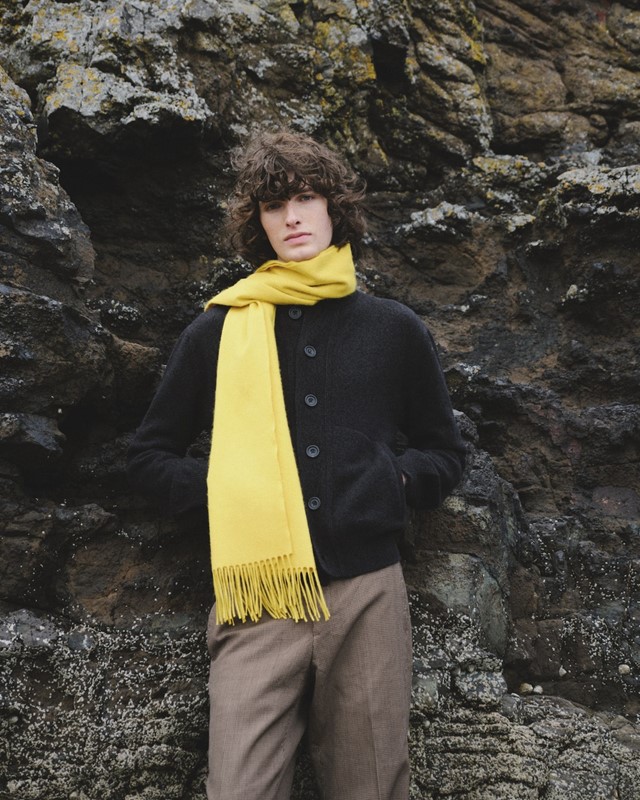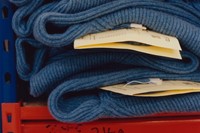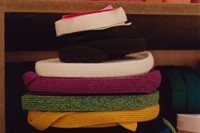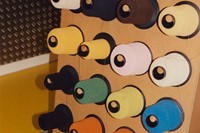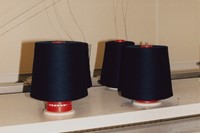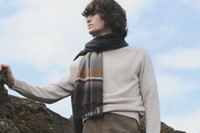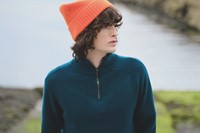Begg x Co’s mills have been crafting cashmere for more than a century. Here, AnOther is given unprecedented access to some of the skilled makers, who reveal what makes Scottish cashmere the finest in the world
How much would you spend on the perfect cashmere sweater? A well-crafted, ethically-made knit with longevity in your wardrobe might command a high price tag, but the market for these subtle status items is there – and this year, it boomed. These so-called ‘quiet luxury’ pieces are usually made by veteran craftspeople at heritage ateliers in Paris or Milan – however, closer to home, there are inconspicuous, unlikely havens where craft has been handed down for decades, sometimes centuries. Nestled in the chilly coastal town of Ayr on the south-west coast of Scotland, Begg x Co’s mills loom only the finest of cashmere yarns, unparalleled in quality. From the initial shearing to the final stitch, the devoted and discerning hands it travels through to make one unfussy, artisanal product make an astounding conveyor belt of meticulous making. Processes are refreshingly unhurried, given the time they require, and the outcome is, for sure, an indulgence.
Begg x Co has the credentials to justify the expense. Alex Begg had been producing hand-woven shawls in the town of Paisley since 1862, until he decided to relocate his cashmere factory to the town of Ayr forty years later. Where the mist whirls off the Firth of Clyde, and regular rainfall flows from the lush Ayrshire hills, the area’s soft water supplies the mills with the optimum wash to make their cashmere the finest in the world. For years, the mills acted as a supplier for the world’s finest fashion and home brands until 2013, when the company began a global campaign to offer its own contemporary collection of cashmere splendour. Begg & Co, as it was first christened, was born.
An in-house design team was ushered in to transport the company into its new era. With a seasoned eye for colour, creative director Angela Bell was plucked from her position as founder of the contemporary Scottish label Queene and Belle, arriving to offer a new, relevant, and modern twist on some age-old traditions. This unique expertise introduced womenswear, menswear, homewares, and a luxurious new era, transformed from suppliers to a fully-fledged lifestyle brand. “Cashmere has this quiet undertone of luxury, and it never dates,” Bell says over Zoom from her studio in Scotland. “My whole family has worked in the cashmere industry here for hundreds of years. I’ve still got a lot of vintage pieces from my grandfather, who was a hand-intarsia knitter. It’s in my blood.”
Despite some of the machinery in their mills being over 100 years old, the creative team’s contemporary approach reveals itself in small details, in colour and in delicate jacquards. Yet, the star remains its exceptional quality cashmere cloth. “The cashmere that comes out of Scotland has a certain kind of sparkle and cleanness in the hand. Why would Chanel invest in a factory here if it wasn’t the best? Cashmere is made in the Far East, it’s made in Italy, but this is its proper home,” says Bell. “Begg x Co always has an eye to the future and knows that great things take time to develop.”

Many of the processes behind cashmere feel shrouded in mystery. Manufacturing one garment is a complex process with a labour-intensive chain of procedures; it takes 20 pairs of hands and 19 processes to create their hero Yacht cardigan, and one misstep can take their artisans back to square one. “When people come to the factory, they’re often blown away by how strange the garment looks before it gets washed,” Bell says. “It can be hard and not pretty-looking, and that’s because the yarn we use in Scotland is greasy, with a coating to protect it. Once the garment is knitted, linked and sewn, it goes through the wash, and that’s when the magic happens.”
It’s not a razzle-dazzle type of magic, more a low-key, ‘if you know you know’ sense of splendour – meanwhile, the dedicated makers rarely realise this magic in the earlier steps of the manufacturing chain. Still, Begg x Co ensures that every employee understands how splendid the finished product evolves to become. “We show everybody the campaigns, the lookbooks, and they love that. To take people on that journey with you is important. It’s a small team, and it feels familial.”
Given unprecedented access to talk to some of the skilled makers behind Begg x Co’s spectacularly crafted garments, AnOther speaks to a few members of their team, many of whom are local to the region with family connections to the cashmere trade, who unveil the specifics behind their labours and what exactly makes Begg x Co so special.
Leah Inglis, Lead Product Developer
“My family, as well as many other colleagues’ families, have deep roots within the knitwear industry. My father, grandmother and grandfather all worked in the industry the whole of their lives. My great-grandmother was a collar linker & my great-grandfather was a frame worker – he actually worked the same frame that we still use in the factory today. When Begg x Co acquired the business I worked for [Scott & Charters] they became more committed to developing the people who work there. They recognised me as someone they could nurture, which has led to my progression as lead product developer, where I oversee and coordinate the new developments through our internal development process. There are no two days the same! We only use 100 per cent natural fibres and are conscious of the supply chain we use when sourcing yarn, right down to where the fibres to produce the yarn we use come from, and we do not overproduce samples, so we can ensure our process aligns with the sustainability values of the company.”
Anthony Waters, Shima Programmer
“As a Shima Seiki programmer in the development team at Begg x Co, my key role is translating designer visions into knitting machine programs. This involves digitising intricate knit patterns, calibrating stitch settings, and inspecting fabric quality at the sampling stage. My programming expertise and collaboration with the design team are crucial for bringing innovative luxury knitwear concepts seamlessly to life. Collaboration is essential in bringing designers’ creative visions to life, which is why we meet cross-functionally as a new product development team to review both the aesthetic vision and technical requirements. It is deeply fulfilling to turn ultra-soft cashmere into beautiful final products through my programming skills and attention to detail, and it is great being surrounded by a team of talented and enthusiastic individuals who share a love for knitwear.”
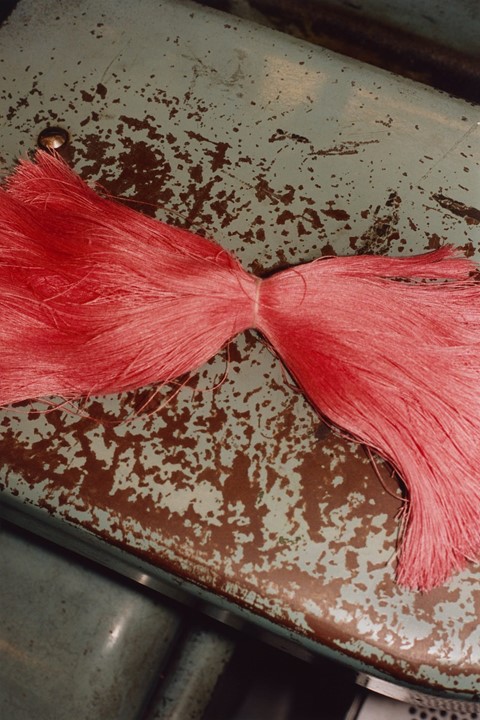
Tracey Casson, Cutting & Collar Linking
“Within my role, I am the designated sample collar linker, which involves first trials of styles and working out the best construction methods. I also work on the production line and I’m skilled in cutting, so I support this area when needed. I’ve been at the company for just over five years; it first appealed to me through a family connection, and it has a great, friendly atmosphere. The techniques that are used are ones that have been used for hundreds of years within the knitwear industry. Traditionally styles would be round-necks or V-necks, whereas nowadays designers want something unique, meaning styles are becoming more complex. With more complex styles comes new challenges on how to adapt our traditional techniques. It’s a highly skilled job where you’re learning new and better ways of linking and trialling different methods to work out what works best.”
Caroline Muir, hand-sewing
“I am the sample hand-sewer, but also work on main production garments. My role involves finishing off garments doing things like closing necks and hand embroidery onto garments. Every garment comes through hand-sew, where we finish it off. All of this is done by hand, and most things we do are invisible – people can’t see what we’ve done and would be surprised to know it’s been hand-sewn. Sewers go into every stitch, meaning the heavier the garment, the bigger the stitch. This can make it more difficult to hide what we do on heavier gauge garments. Learning the knacks of the trade is key, this can only be done through knowledge that is gained by experience being passed on. Every garment we produce has an element of hand sewing in it, meaning our craftsmanship goes into every single garment we produce.”
